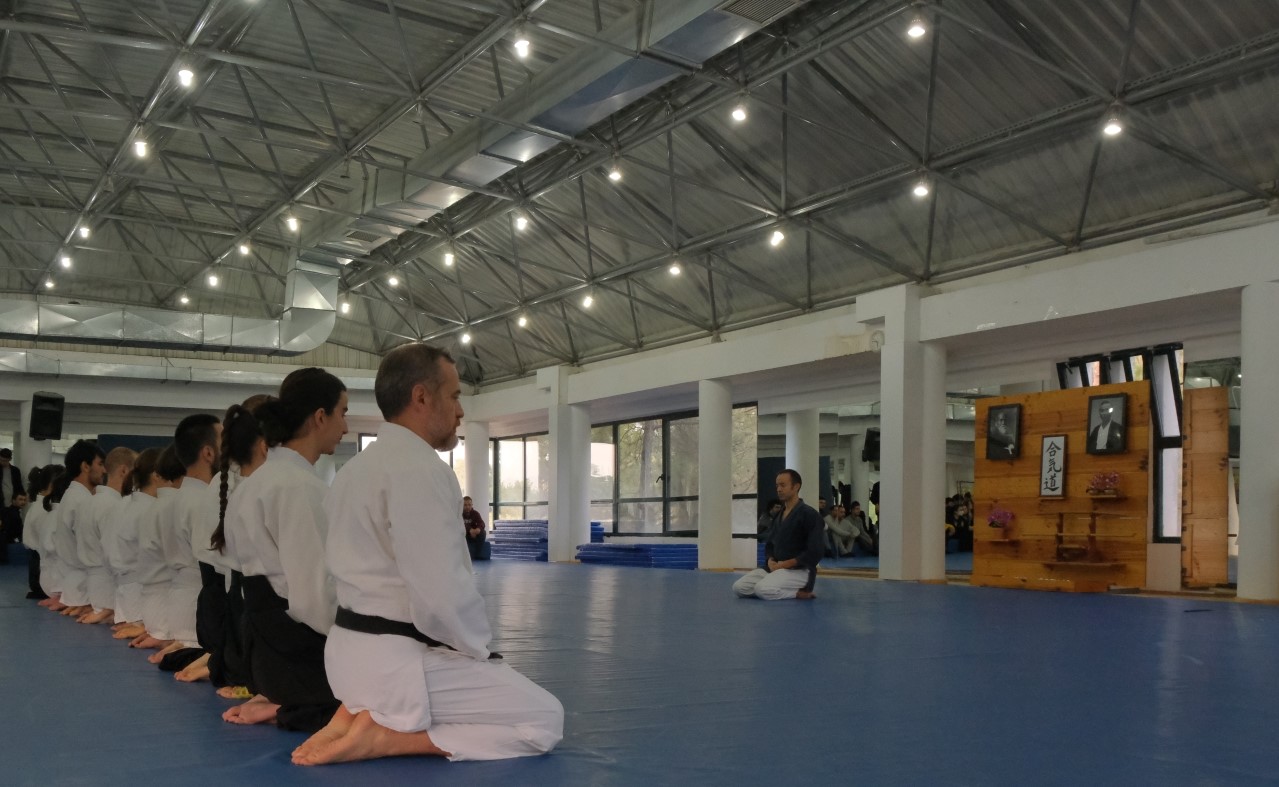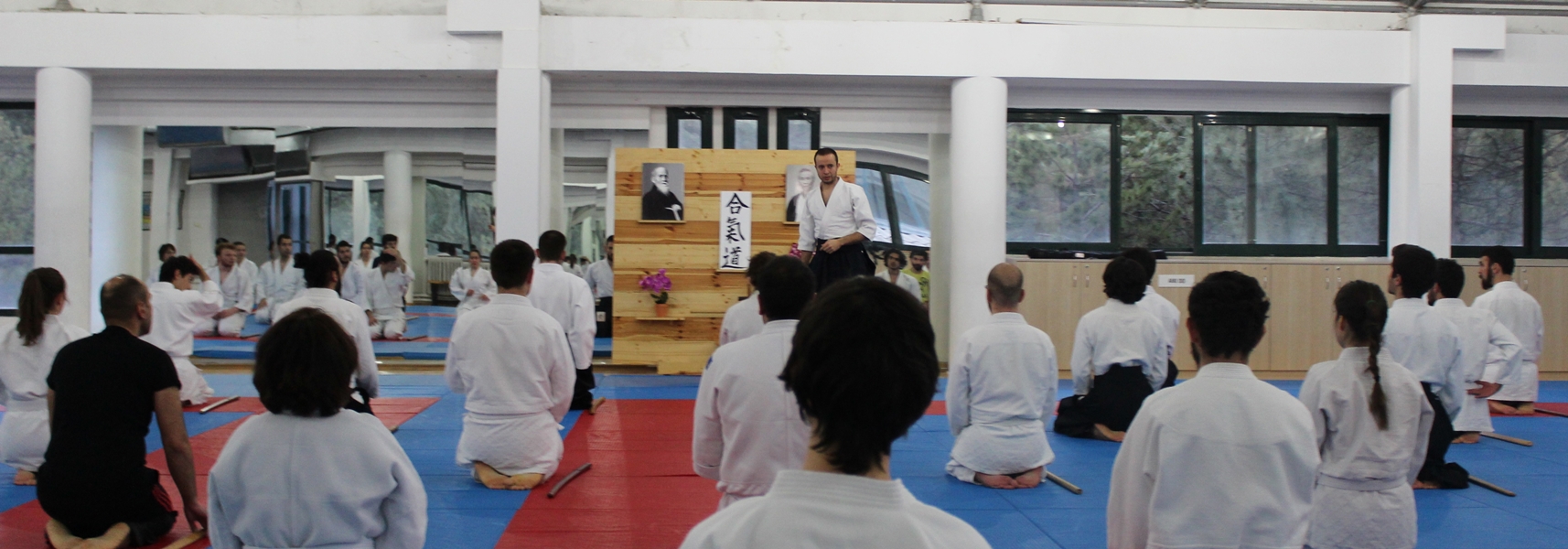POSITIONS
Hanmi:
Triangular posture. Usually, the techniques of Aikido are practiced with positions that are determined beforehand. The reason of that is to learn the techniques and the principles of posture against incoming attacks.
Kamae:
Posture or stance with or without weapons. Kamae also means arranging the distance and timing (ma-ai) between the enemy. Although kamae generally means that a physical position, there is a correlation between physical posture and psychological state. A strong presence helps to establish a strong mind.
Ai Hanmi:
The position that the uke and the nage stands opposed with the same hand and feet.(left-left feet; right-right feet).
Gyaku Hanmi:
Reverse\Cross position. (If the uke’s right feet is in front, then the nage’s left feet is and vice versa).
Hanmi Handachi:
The position where the uke is standing up and the nage is sitting on the floor. Hamni Handachi provides a training like there is a stronger and a taller uke in front of the nage. A study like that improves the hara, the center of the body.
Suwari Waza:
Suwari means sitting. Suwariwaza is the techniques that are done while sitting. In Aikido trainings the nage and the uke is on the floor when studying suwariwaza. It helps the lower body to work with the whole body efficiently
Tachi Waza:
Tachi means standing up. Tachiwaza is the techniques that are done while standing up.
Ushiro Waza:
These are the techniques against incoming attacks from the back. Uke attacks the nage from the back.
BODY SUBSTITUTIONS
Irimi:
The word “irimi” means “entering the center of the enemy”. The entering movement; irimi, is the technique that forms the basis of Aikido. The purpose of this technique is to get to most suitable position against the enemy, to prevent the attacks coming from it, and to control its balance effectively. The physical meaning of irimi is to dodge to the side of the enemy and prevent to attack, but the spiritual meaning is to eliminate a violent power.
Tenkan:
A technique that especially turns the body 180 degrees.
Irimi Tenkan:
Entering and turning. The irimi and tenkan combinations are used according to the situations.
ATTACKS
Aihanmi Katatedori:
One hand holds the nage’s same side wrist.(right hand-right wrist)
Gyaku Hanmi Katatedori:
In the cross position, one hand holds the nage’s other side wrist.(right hand-left wrist)
Ryote Dori:
Both hands hold the nage’s both wrists.(The position of the feet are Gyaku Hanmi)
Morote Dori:
Both hands holds the nage’s one wrist.
Hiji Dori:
Holding the elbow of the nage.
Kata Dori:
Holding one shoulder of the nage.
Ryokata Dori:
Holding both shoulders of the nage.
Mune Dori:
Holding the collar of the nage with both hands.
Eri Dori:
Holding the nage’s collar from the nape side with one hand.
Men Uchi:
A cutting movement to head.
Shomen Uchi:
A cutting movement to head from upwards.
Yokomen Uchi:
A cutting movement to a side of the head from upwards.
Kata Dori Men Uchi:
Hitting nage’s head while holding its shoulder with another hand.
Mune Dori Men Uchi:
Hitting nage’s head while holding its collar with another hand.
Chudan Tsuki:
A hit to nage’s hara. It is done by fists if uke is unarmed.
Jodan Tsuki:
A hit to nage’s upper body (especially head). It is done by fists if uke is unarmed.
Kubi Shime:
The technique of choking the nage. While one hand holds the nage’s wrist, the other hand holds its collar and chokes from the back.
FREQUENTLY USED CONCEPTS
Atemi:
A hit, strike. A stunning attack to enemy’s vital organs.
Dojo
It literally means where the road (do) takes place. A dojo (a training place), is a little universe where we contact directly with our concerns and usual habits. This place is an arena, that we fight the hindrances of ourselves in. In this arena, the people who oppose us are not our enemies, but friends who help us to understand ourselves better.
Gi:
The clothing worn in training.
Hakama:
The formal clothing in Aikido. It is worn by the higher level of Aikido students. It is similar to a long skirt.
Hara:
The center of mass of the one. It is at the four finger length down from the belly button. It is where the Ki stored.
Dan:
It literally means the first step. It is the indicator of starting the art of Aikido. Dan degrees are taken at the black belt level.
Kyu:
White belt levels, ranks. Kyu degrees are the 6 degreees until Shodan (1.Dan).
Henka Waza:
Changing, variable techniques. Especially used when the one starts with a technique but finishes with another.
Jiyu Waza:
The techniques studied in free style. Usually, in this method of study, more than one ukes attack the nage.
Kokyu:
Literally breathing. A part of Aikido is to develop the one’s power of breathing. That is the harmony between breath and the movement. The control of the breath enables to concentrate and to destroy stress and fear. In Aikido, many of the techniques are classified as KOKYU HO (breathing exercises). These exercises help to develop the one’s KOKYU RYOKUYU (power of breathing).
Mae:
Front
Mae Ukemi:
Falling consciously to the front in a circular position and getting up.
Ushiro
Back, behind.
Ushiro Ukemi:
Falling consciously to the back in a circular position.
Maai:
Ordinate distance, secession, and timing that has to be arranged according to enemy’s location. It is the unification of distance, timing, and speed.
Nage:
Nage is the throwing person. It is the one who does the techniques in training.
Uke:
Uke is the person who is being thrown. In higher levels, the difference between uke and nage becomes indistinct. The reason of that is in higher levels, also the person who starts the technique is unclear, and the uke and the nage is coherent and at the same pace.
Omote:
Front side. In Aikido, this is classified as the techniques that the nage gets into uke’s front side.
Ura:
These Aikido techniques are classified as the uke gets the nage’s behind or one side while doing the technique. Sometimes these techniques are called Tenkan (turning) techniques.
Shikko:
Walking on the knees. Also called as Samurai walking. It helps to develop a strong hara concept in the one’s body. It also helps to strengthen the hips and the feet.
Seiza:
Sitting on the knees. Sitting like this for a long time takes practice, but it establishes a strong balance and provides free movement compared to sitting in cross legged position.
Tai Sabaki:
Conscious body movements.





